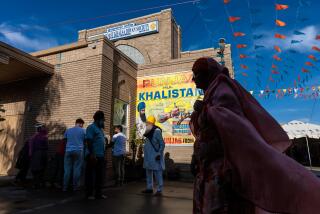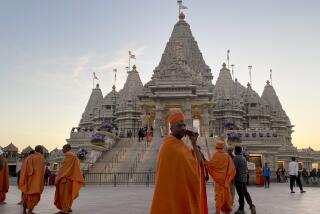Popularity of Hinduism, Related Teachings Rises in U.S. : Faith: More than 1 million devotees live here, but many millions more use such elements as yoga and meditation.
- Share via
CHICAGO — By early afternoon, the thermometer was pushing 100 and the asphalt surface of the Soldier Field parking lot was blistering to the touch. At one edge of the lot, four large, open-sided tents sat clustered and baking in the bright sunlight.
In the largest of the tents, a football field-size affair holding about 3,000 chanting Hindu worshipers, it was even hotter.
Inside the tent, acrid, black smoke spiraling upward from hundreds of small ritual fires fed by clarified butter and Indian spices settled over the crowd. The smoke was so thick, it obscured the 10 orange-robed Hindu priests seated onstage playing instruments, chanting mantras and instructing participants in the intricacies of the ancient ritual.
Yet despite the horrendous heat, virtually no one left the tent, save a few mothers carrying crying children. Instead, they sat cross-legged on mats for 90 minutes as the fires burned.
For the devotees, the smoke and heat were a spiritually purifying experience, appropriate for their worship of the sun goddess Gayatri, who represents the source of all earthly life.
The location was equally appropriate. Hinduism was formally introduced to America in Chicago by Indian religious leader Swami Vivekenanda at the 1893 Parliament of the World’s Religions. And at last month’s festival, it was evident just how much the 5,000-year-old teachings of Hinduism--the world’s oldest major religion--have become a part of the changing American religious scene.
“The history of Hinduism in America is still being written,” said Diana Eck, a Harvard University professor of comparative religion and Indian studies. “It’s much too early to say how it will affect this country and how it will ultimately be affected by this society.
“But clearly it’s here to stay and will continue to grow.”
Eck and others put the U.S. Hindu population at about 1.2 million--a tiny fraction of the 800 million Hindus worldwide.
The vast majority of American Hindus are Indian immigrants who began arriving in great numbers after 1965, when immigration laws were loosened, and now reside in high concentrations around large cities, such as Los Angeles, New York City, Houston, Washington and Chicago.
Others are people of Indian descent whose ancestors left the Asian subcontinent generations ago. Hinduism Today, an international Hindu monthly newspaper based in Kauai, Hawaii, recently noted the presence of more than 200,000 Hindus from the South American nation of Guyana living in New York City.
“In many families it has been several generations since a member set foot on Indian soil yet the music, the dance, the foods--but most especially the religion--are an integrated part of their lives,” the paper said.
A small number of non-Indian Americans also have fully adopted Hindu religious practices, such as the 12,000 “initiates” who belong to the International Society of Krishna Consciousness--more popularly known as the Hare Krishnas.
However, many more Americans--estimates run into the millions--have incorporated such elements of Hinduism as meditation and yoga into their lives as a spiritual supplement or just to help relieve stress. Most of those consider themselves Christians or Jews and wouldn’t dream of calling themselves Hindus, Eck said.
Not that this matters to Hindus. Stripped of its Indian cultural trappings--which are considerable--Hinduism presents itself as a statement of universal understanding about the nature of reality, open to as many interpretations as there are people. Its boundaries are broad enough to encompass a dazzling array of philosophies and practices.
Hindu scripture--a set of writings known as the Vedas, or “knowledge” in the ancient Sanskrit language--says there are 33 million divinities and Hindus are free to regard one or any combination of them in a literal sense. But these deities can also be thought of as mere symbols of the many ways in which one all-pervasive supreme entity, or creative energy, manifests itself in the physical world.
“Hinduism is not so much one religion as it is a collection of 10,000 related religions that intermingle,” said Palaniswami, an American-born non-Indian who 30 years ago became a Hindu monk and today edits the Hindu monthly.
“Hinduism has no outer limit, no picket fence. You can be an atheist, believe in a personal God, or that everything in this world is an illusion, and still be a good Hindu because the Hindu heart loves the all-embracing approach. There is a trust that each soul knows what it needs in this lifetime and creates that for itself.”
Hinduism’s permeability allows 53-year-old Prithvi Raj Singh to include a Christian cross among the images of Hindu deities on his home altar in Diamond Bar.
“According to our definition, anyone who is doing something good is like an incarnation of God. Jesus is also that for me, but I am not a Christian,” he said.
In India, myriad Hindu sects based on regional loyalties to particular deities and practices hold sway. Hindus have brought that aspect of the faith with them to the United States.
The majority of those at Soldier Field, for example, were associated with the Gayatri Pariwar sect popular in the west Indian state of Gujarat. They came from as far away as Montreal and California for the Ashwamedh Yagya fire ceremony, a ritual once reserved for kings. Gayatri Pariwar, which claims followers in 86 nations, is but one of a host of Hindu groups now established in this country.
“I don’t see much difference between the way Hinduism is practiced in the United States and the way it is practiced in India,” said Singh, who is president of Southern California’s Federation of Hindu Assns. “People remain loyal to their regional deities and practices and group themselves accordingly wherever they are.”
That is not to say that life in America has not affected the practice of Hinduism. One change is the importance placed here on weekend temple worship.
In India, Hinduism is largely home-based, with the practice of meditation, the recitation of mantras (word combinations believed capable of evoking the presence of specific deities) and even miniature fire rituals taking place before a small altar on which images of favored divinities are placed. Moreover, temples and public shrines are everywhere in Hindu India, allowing individuals to worship at any time.
Here, home worship is still the backbone of Hindu practice, but the nation’s 827 Hindu temples also have taken on a cultural role unknown in India and distinctly apart from their religious significance.
To accommodate the American workweek, Sunday has become a favored day for temple attendance, but not just for worship. Classes in Indian culture, language, dancing and cooking are also held in an effort to counter what many Hindus fear will be an inevitable diminishing attachment to Indian beliefs and customs among those born into America’s religious and ethnic melting pot.
“A lot of people who were not very religiously involved in India go to temples in the U.S. because they’re worried about their children,” said Lise McKean, an anthropologist who has studied Gayatri Pariwar in India and who is the managing editor of the University of Chicago’s journal Public Culture.
“Their concern is common to most immigrant groups.”
More to Read
Sign up for Essential California
The most important California stories and recommendations in your inbox every morning.
You may occasionally receive promotional content from the Los Angeles Times.













